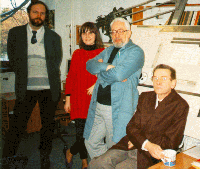This page was accessed

times since February 19, 1996
Lidar Laboratory
The people
The photo shows the lab personel as of 1996. From left to right on
 the photo (72 kB)
the photo (72 kB)
- Dr. Jacek Piskozub
- working on lidar inverse problems and radiation transfer problems; head of the laboratory (1993-2000); author of this page
-
M. Violetta Drozdowska - working on her PH.D. on fluorescence lidar data
-
Eng. Miroslaw Irczuk - our laser engineer
- Prof. Andrzej Zielinski - founder of the group, v-ce director of
the institute
- Dr. Tymon Zielinski (not in the photo, member of the group since 1998) -
working in the field of marine aerosol)
- Assoc. Prof. Tadeusz Król (not in the photo, member and head of the group January-December 2001)
Research subjects:
The main research themes are:
- study of density and size distribution of marine aerosol in the
boundary layer over sea surface and in the coast zone,
- studies on remote sensing of spatial distribution of chlorophyll in
near-surface layer of the sea as well as oil pollution on sea surface,
- theoretical studies on the solution of inverse lidar problem for
multifrequency lidar systems (Dr. Jacek Piskozub).
The output beam of our lidar system clearly visible on this
slightly moved photo made in the Marine
Station of Gdansk University
on Hel Peninsula in 1993 during marine aerosol measurements.
History of the Lidar Laboratory
Lidar Laboratory in Institute of Oceanology PAS exists since January 1993.
However the history of the lidar group in IO PAS is longer. It was created
in the early 1980s by Prof. Andrzej Zielinski. In 1992 it bought the lidar
system (FLS-12) we have been since using. The purchase was possible thanks
to
Committee for Scientific Research
(KBN) research grant.
In years 1993-2000
Dr. Jacek Piskozub was the leader of the laboratory, followed in 2001 by Asoc. Prof. Tadeusz Krol.
In the last 8 years we have participated in more than 20 research cruises on R/V Oceania
and more than 30 shore experiments (including 4 international, one in Duck, North Carolina).
A three year research grant for lidar study of sea-surface oil
pollution (1996-1998) resulted in purchasing a new lidar system FLS-UV for measuring thickness
of the oil films on the surface using the attenuation of water Raman scattering.
The lidar is placed on an old-but-faithful East-German Robur truck (scrapped in 1998)
during a BAEX experiment
in Lubiatowo on the Polish stretch of the southern Baltic shore.
The simple mirror device attached to the truck enables vertical sounding
of the atmosphere. Horizonthal and sloped profiles are made by tilting the
lidar device itself.
The Lidar
We use a dual purpose FLS-12 lidar built in Estonia by LDI Ltd.
The lidar on s/y Oceania cruise in
South Baltic. The laser and the telescope are aimed at an open porthole. The beam is aimed to zenith or to sea-surface by a mirror placed outside the porthole.
The lidar uses a tunable dye-laser pumped by eximer laser.
The reciving block consists of a 200 mm diameter telescope and two
interchangable blocks:
- Photo-muliplier with 1024 time-gated channels for aerosol profile taking.
- CCD camera with 1024 spectral channels
The lidar mirror for chlorophyll concentration measurements.
In background one of the oil drilling platforms and a tanker,
north from Rozewie in the Polish economic zone. This site has been
selected for future lidar oil-film measurements as a part of a new project
we will soon start working on.
Our Output
Here is an example of aerosol concentration map. The lidar measurements
were done in Lubiatowo, Poland during a BAEX-2 international experiment.
An interesting example of the field of aerosol concentration
calculated from our measurements is
shown above. The measurements were done with the lidar
standing 60 m from the shore. The wind blew with 2 m/s velocity from
the land. The dropping out of land aerosol can be clearly traced. An
aerosol plume is visible about 100 m over the sea. The increasing values
over 450 m from lidar are caused by due marine aerosol generation.
 the photo (72 kB)
the photo (72 kB)
